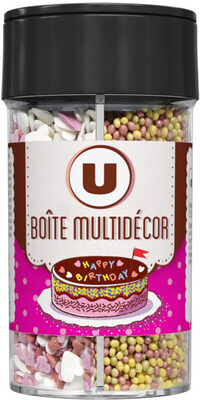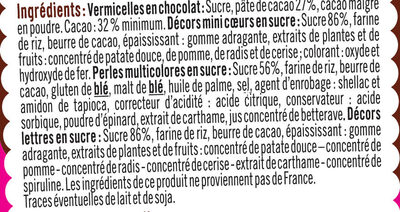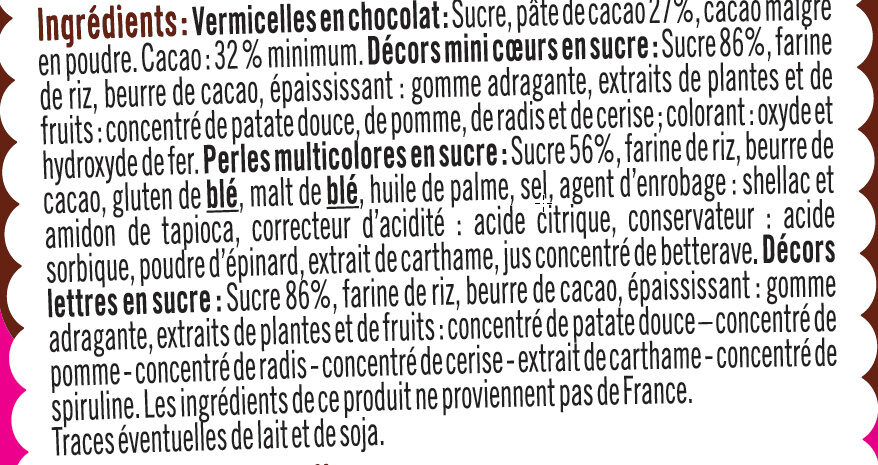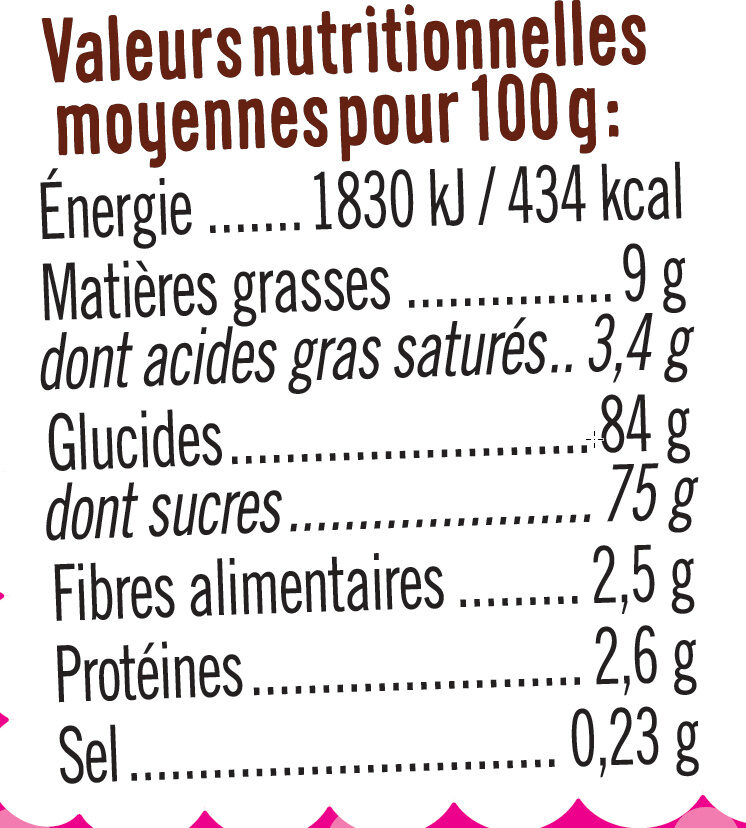Help us make food transparency the norm!
As a non-profit organization, we depend on your donations to continue informing consumers around the world about what they eat.
The food revolution starts with you!
Multidécors - U - 138 g
Multidécors - U - 138 g
This product page is not complete. You can help to complete it by editing it and adding more data from the photos we have, or by taking more photos using the app for Android or iPhone/iPad. Thank you!
×
Some of the data for this product has been provided directly by the manufacturer Système U.
Barcode: 3256226383435 (EAN / EAN-13)
Quantity: 138 g
Packaging: Box
Brands: U
Categories: Cooking helpers, Sugary cooking helpers
Labels, certifications, awards: Packaged in France
Stores: Magasins U
Countries where sold: France
Matching with your preferences
Health
Ingredients
-
50 ingredients
: Vermicelles au chocolat: sucre, pâte de cacao 27%, cacao maigre en poudre. Cacao: 32% minimum. Décors mini coeurs en sucre : sucre 86%, farine de riz, beurre de cacao, épaississant: gomme adragante, jus concentré de betterave, denrées alimentaires colorantes: concentrés de patate douce - de pomme - de radis et de cerise, colorant : bêta-carotène. Perles multicolores en sucre: sucre 56%, farine de riz, beurre de cacao, GLUTEN DE BLE, MALT de BLE, huile de palme, sel, agents d'enrobage : shellac et amidon de tapioca, correcteur d'acidité : acide citrique, conservateur : acide sorbique, denrées alimentaires colorantes: poudre d'épinard et extrait de carthame, jus concentré de betterave. Décors lettres en sucre: sucre 86%, farine de riz, beurre de cacao, épaississant : gomme adragante, denrées alimentaires colorantes: concentré de patate douce - de pomme - de radis - de cerise - de spiruline, extrait de carthame. Traces éventuelles de lait et de soja.Allergens: Gluten, fr:amidon-de-tapioca, fr:beurre-de-cacao, fr:conservateur-acide-sorbique, fr:correcteur-d-acidite-acide-citrique, fr:extrait-de-carthame, fr:extraits-de-plantes-et-de-fruits-concentre-de-patate-douce-concentre-de-pomme-concentre-de-radis-concentre-de-cerise-extrait-de-carthame-concentre-de-spiruline-les-ingredients-de-ce-produit-ne-proviennent-pas-de-franceTraces: Milk, Soybeans, fr:farine-de-riz, fr:jus-concentre-de-betterave-decors-lettres-en-sucre-sucre-86, fr:poudre-d-epinard, fr:epaississant-gomme-adragante
Food processing
-
Ultra processed foods
Elements that indicate the product is in the 4 - Ultra processed food and drink products group:
- Additive: E160a - Carotene
- Additive: E413 - Tragacanth
- Additive: E904 - Shellac
- Ingredient: Colour
- Ingredient: Glazing agent
- Ingredient: Gluten
- Ingredient: Thickener
Food products are classified into 4 groups according to their degree of processing:
- Unprocessed or minimally processed foods
- Processed culinary ingredients
- Processed foods
- Ultra processed foods
The determination of the group is based on the category of the product and on the ingredients it contains.
Additives
-
E160a - Carotene
Carotene: The term carotene -also carotin, from the Latin carota, "carrot"- is used for many related unsaturated hydrocarbon substances having the formula C40Hx, which are synthesized by plants but in general cannot be made by animals -with the exception of some aphids and spider mites which acquired the synthesizing genes from fungi-. Carotenes are photosynthetic pigments important for photosynthesis. Carotenes contain no oxygen atoms. They absorb ultraviolet, violet, and blue light and scatter orange or red light, and -in low concentrations- yellow light. Carotenes are responsible for the orange colour of the carrot, for which this class of chemicals is named, and for the colours of many other fruits, vegetables and fungi -for example, sweet potatoes, chanterelle and orange cantaloupe melon-. Carotenes are also responsible for the orange -but not all of the yellow- colours in dry foliage. They also -in lower concentrations- impart the yellow coloration to milk-fat and butter. Omnivorous animal species which are relatively poor converters of coloured dietary carotenoids to colourless retinoids have yellowed-coloured body fat, as a result of the carotenoid retention from the vegetable portion of their diet. The typical yellow-coloured fat of humans and chickens is a result of fat storage of carotenes from their diets. Carotenes contribute to photosynthesis by transmitting the light energy they absorb to chlorophyll. They also protect plant tissues by helping to absorb the energy from singlet oxygen, an excited form of the oxygen molecule O2 which is formed during photosynthesis. β-Carotene is composed of two retinyl groups, and is broken down in the mucosa of the human small intestine by β-carotene 15‚15'-monooxygenase to retinal, a form of vitamin A. β-Carotene can be stored in the liver and body fat and converted to retinal as needed, thus making it a form of vitamin A for humans and some other mammals. The carotenes α-carotene and γ-carotene, due to their single retinyl group -β-ionone ring-, also have some vitamin A activity -though less than β-carotene-, as does the xanthophyll carotenoid β-cryptoxanthin. All other carotenoids, including lycopene, have no beta-ring and thus no vitamin A activity -although they may have antioxidant activity and thus biological activity in other ways-. Animal species differ greatly in their ability to convert retinyl -beta-ionone- containing carotenoids to retinals. Carnivores in general are poor converters of dietary ionone-containing carotenoids. Pure carnivores such as ferrets lack β-carotene 15‚15'-monooxygenase and cannot convert any carotenoids to retinals at all -resulting in carotenes not being a form of vitamin A for this species-; while cats can convert a trace of β-carotene to retinol, although the amount is totally insufficient for meeting their daily retinol needs.Source: Wikipedia
-
E160ai - Beta-carotene
Beta-Carotene: β-Carotene is an organic, strongly colored red-orange pigment abundant in plants and fruits. It is a member of the carotenes, which are terpenoids -isoprenoids-, synthesized biochemically from eight isoprene units and thus having 40 carbons. Among the carotenes, β-carotene is distinguished by having beta-rings at both ends of the molecule. β-Carotene is biosynthesized from geranylgeranyl pyrophosphate.β-Carotene is the most common form of carotene in plants. When used as a food coloring, it has the E number E160a. The structure was deduced by Karrer et al. in 1930. In nature, β-carotene is a precursor -inactive form- to vitamin A via the action of beta-carotene 15‚15'-monooxygenase.Isolation of β-carotene from fruits abundant in carotenoids is commonly done using column chromatography. It can also be extracted from the beta-carotene rich algae, Dunaliella salina. The separation of β-carotene from the mixture of other carotenoids is based on the polarity of a compound. β-Carotene is a non-polar compound, so it is separated with a non-polar solvent such as hexane. Being highly conjugated, it is deeply colored, and as a hydrocarbon lacking functional groups, it is very lipophilic.Source: Wikipedia
-
E200 - Sorbic acid
Sorbic acid: Sorbic acid, or 2‚4-hexadienoic acid, is a natural organic compound used as a food preservative. It has the chemical formula CH3-CH-4CO2H. It is a colourless solid that is slightly soluble in water and sublimes readily. It was first isolated from the unripe berries of the Sorbus aucuparia -rowan tree-, hence its name.Source: Wikipedia
-
E330 - Citric acid
Citric acid is a natural organic acid found in citrus fruits such as lemons, oranges, and limes.
It is widely used in the food industry as a flavor enhancer, acidulant, and preservative due to its tart and refreshing taste.
Citric acid is safe for consumption when used in moderation and is considered a generally recognized as safe (GRAS) food additive by regulatory agencies worldwide.
-
E413 - Tragacanth
Tragacanth: Tragacanth is a natural gum obtained from the dried sap of several species of Middle Eastern legumes of the genus Astragalus, including A. adscendens, A. gummifer, A. brachycalyx, and A. tragacantha. Some of these species are known collectively under the common names "goat's thorn" and "locoweed". The gum is sometimes called Shiraz gum, shiraz, gum elect or gum dragon. The name derives from the Greek words tragos -meaning "goat"- and akantha -"thorn"-. Iran is the biggest producer of this gum. Gum tragacanth is a viscous, odorless, tasteless, water-soluble mixture of polysaccharides obtained from sap that is drained from the root of the plant and dried. The gum seeps from the plant in twisted ribbons or flakes that can be powdered. It absorbs water to become a gel, which can be stirred into a paste. The major fractions are known as tragacanthin, highly water soluble as a mucilaginous colloid, and the chemically related bassorin, which is far less soluble but swells in water to form a gel. The gum is used in vegetable-tanned leatherworking as an edge slicking and burnishing compound, and is occasionally used as a stiffener in textiles. The gum has been used historically as a herbal remedy for such conditions as cough and diarrhea. As a mucilage or paste, it has been used as a topical treatment for burns. It is used in pharmaceuticals and foods as an emulsifier, thickener, stabilizer, and texturant additive -E number E413-. It is the traditional binder used in the making of artists' pastels, as it does not adhere to itself the same way other gums -such as gum arabic- do when dry. Gum tragacanth is also used to make a paste used in floral sugarcraft to create lifelike flowers on wires used as decorations for cakes, which air-dries brittle and can take colorings. It enables users to get a very fine, delicate finish to their work. It has traditionally been used as an adhesive in the cigar-rolling process used to secure the cap or "flag" leaf to the finished cigar body.Gum tragacanth is less common in products than other, usually cheaper, gums, such as gum arabic or guar gum. Different gums tend to be interchangeable across many uses, and production of tragacanth is far outpaced by these for reasons of economy, trade, agriculture and history, while tragacanth is mostly produced in traditional locations. However, gums are used in varied circumstances and there are many situations where tragacanth is considered superior. Common substitutions are methyl cellulose, sometimes marketed as "substitute gum tragacanth" in the food industry, and gum karaya. Gum karaya, also called "Indian tragacanth" or simply "tragacanth", might be fully or partially substituted for what appears to be genuine tragacanth. Gum tragacanth is also used in incense-making as a binder to hold all the powdered herbs together. Its water solubility is ideal for ease of working and an even spread, and it is one of the stronger gums for holding particles in suspension. Only half as much is needed, compared to gum arabic or something similar.In Saudi Arabia, a mixture of hydrated Tragacanth and ground dried Ziziphus spina-christi is used as a natural hair shampoo that is believed to promote hair growth.Source: Wikipedia
-
E904 - Shellac
Shellac: Shellac is a resin secreted by the female lac bug, on trees in the forests of India and Thailand. It is processed and sold as dry flakes -pictured- and dissolved in alcohol to make liquid shellac, which is used as a brush-on colorant, food glaze and wood finish. Shellac functions as a tough natural primer, sanding sealant, tannin-blocker, odour-blocker, stain, and high-gloss varnish. Shellac was once used in electrical applications as it possesses good insulation qualities and it seals out moisture. Phonograph and 78 rpm gramophone records were made of it until they were replaced by vinyl long-playing records from the 1950s onwards. From the time it replaced oil and wax finishes in the 19th century, shellac was one of the dominant wood finishes in the western world until it was largely replaced by nitrocellulose lacquer in the 1920s and 1930s.Source: Wikipedia
Ingredients analysis
-
Palm oil
Ingredients that contain palm oil: Palm oil
-
Non-vegan
Non-vegan ingredients: E904Some ingredients could not be recognized.
We need your help!
You can help us recognize more ingredients and better analyze the list of ingredients for this product and others:
- Edit this product page to correct spelling mistakes in the ingredients list, and/or to remove ingredients in other languages and sentences that are not related to the ingredients.
- Add new entries, synonyms or translations to our multilingual lists of ingredients, ingredient processing methods, and labels.
If you would like to help, join the #ingredients channel on our Slack discussion space and/or learn about ingredients analysis on our wiki. Thank you!
-
Non-vegetarian
Non-vegetarian ingredients: E904Some ingredients could not be recognized.
We need your help!
You can help us recognize more ingredients and better analyze the list of ingredients for this product and others:
- Edit this product page to correct spelling mistakes in the ingredients list, and/or to remove ingredients in other languages and sentences that are not related to the ingredients.
- Add new entries, synonyms or translations to our multilingual lists of ingredients, ingredient processing methods, and labels.
If you would like to help, join the #ingredients channel on our Slack discussion space and/or learn about ingredients analysis on our wiki. Thank you!
-
Details of the analysis of the ingredients
We need your help!
Some ingredients could not be recognized.
We need your help!
You can help us recognize more ingredients and better analyze the list of ingredients for this product and others:
- Edit this product page to correct spelling mistakes in the ingredients list, and/or to remove ingredients in other languages and sentences that are not related to the ingredients.
- Add new entries, synonyms or translations to our multilingual lists of ingredients, ingredient processing methods, and labels.
If you would like to help, join the #ingredients channel on our Slack discussion space and/or learn about ingredients analysis on our wiki. Thank you!
: Vermicelles au chocolat, pâte de cacao 27%, cacao maigre en poudre, Cacao 32% (Décors mini coeurs en sucre), sucre 86%, farine de riz, beurre de cacao, épaississant (gomme adragante), jus concentré de betterave, denrées alimentaires colorantes (de patate douce), de pomme, de radis, de cerise, colorant (bêta-carotène, Perles multicolores en sucre), sucre 56%, farine de riz, beurre de cacao, GLUTEN DE BLE, MALT de BLE, huile de palme, sel, agents d'enrobage (shellac, amidon de tapioca), correcteur d'acidité (acide citrique), conservateur (acide sorbique), denrées alimentaires colorantes (épinard, extrait de carthame), jus concentré de betterave, Décors lettres en sucre (sucre 86%), farine de riz, beurre de cacao, épaississant (gomme adragante), denrées alimentaires colorantes (patate douce), de pomme, de radis, de cerise, de spiruline, extrait de carthame- Vermicelles au chocolat -> fr:vermicelles-au-chocolat
- pâte de cacao -> en:cocoa-paste - vegan: yes - vegetarian: yes - ciqual_proxy_food_code: 16030 - percent: 27
- cacao maigre en poudre -> en:fat-reduced-cocoa-powder - vegan: yes - vegetarian: yes - ciqual_food_code: 18100
- Cacao -> en:cocoa - vegan: yes - vegetarian: yes - ciqual_proxy_food_code: 18100 - percent: 32
- Décors mini coeurs en sucre -> fr:decors-mini-coeurs-en-sucre
- sucre -> en:sugar - vegan: yes - vegetarian: yes - ciqual_proxy_food_code: 31016 - percent: 86
- farine de riz -> en:rice-flour - vegan: yes - vegetarian: yes - ciqual_food_code: 9520
- beurre de cacao -> en:cocoa-butter - vegan: yes - vegetarian: yes - ciqual_food_code: 16030
- épaississant -> en:thickener
- gomme adragante -> en:e413 - vegan: yes - vegetarian: yes
- jus concentré de betterave -> en:beetroot-juice-concentrate - vegan: yes - vegetarian: yes - ciqual_proxy_food_code: 20091
- denrées alimentaires colorantes -> fr:denree-alimentaire-colorante
- de patate douce -> en:sweet-potato - vegan: yes - vegetarian: yes - ciqual_food_code: 4101
- de pomme -> en:apple - vegan: yes - vegetarian: yes - ciqual_food_code: 13050
- de radis -> en:radish - vegan: yes - vegetarian: yes - ciqual_food_code: 20045
- de cerise -> en:cherry - vegan: yes - vegetarian: yes - ciqual_food_code: 13008
- colorant -> en:colour
- bêta-carotène -> en:e160ai - vegan: maybe - vegetarian: maybe - from_palm_oil: maybe
- Perles multicolores en sucre -> fr:perles-multicolores-en-sucre
- sucre -> en:sugar - vegan: yes - vegetarian: yes - ciqual_proxy_food_code: 31016 - percent: 56
- farine de riz -> en:rice-flour - vegan: yes - vegetarian: yes - ciqual_food_code: 9520
- beurre de cacao -> en:cocoa-butter - vegan: yes - vegetarian: yes - ciqual_food_code: 16030
- GLUTEN DE BLE -> en:wheat-gluten - vegan: yes - vegetarian: yes
- MALT de BLE -> en:wheat-malt - vegan: yes - vegetarian: yes - ciqual_proxy_food_code: 9410
- huile de palme -> en:palm-oil - vegan: yes - vegetarian: yes - from_palm_oil: yes - ciqual_food_code: 16129
- sel -> en:salt - vegan: yes - vegetarian: yes - ciqual_food_code: 11058
- agents d'enrobage -> en:glazing-agent
- shellac -> en:e904 - vegan: no - vegetarian: no
- amidon de tapioca -> en:tapioca - vegan: yes - vegetarian: yes - ciqual_proxy_food_code: 9510
- correcteur d'acidité -> en:acidity-regulator
- acide citrique -> en:e330 - vegan: yes - vegetarian: yes
- conservateur -> en:preservative
- acide sorbique -> en:e200 - vegan: yes - vegetarian: yes
- denrées alimentaires colorantes -> fr:denree-alimentaire-colorante
- épinard -> en:spinach - vegan: yes - vegetarian: yes - ciqual_food_code: 20059
- extrait de carthame -> en:safflower-concentrate - vegan: yes - vegetarian: yes
- jus concentré de betterave -> en:beetroot-juice-concentrate - vegan: yes - vegetarian: yes - ciqual_proxy_food_code: 20091
- Décors lettres en sucre -> fr:decors-lettres-en-sucre
- sucre -> en:sugar - vegan: yes - vegetarian: yes - ciqual_proxy_food_code: 31016 - percent: 86
- farine de riz -> en:rice-flour - vegan: yes - vegetarian: yes - ciqual_food_code: 9520
- beurre de cacao -> en:cocoa-butter - vegan: yes - vegetarian: yes - ciqual_food_code: 16030
- épaississant -> en:thickener
- gomme adragante -> en:e413 - vegan: yes - vegetarian: yes
- denrées alimentaires colorantes -> fr:denree-alimentaire-colorante
- patate douce -> en:sweet-potato - vegan: yes - vegetarian: yes - ciqual_food_code: 4101
- de pomme -> en:apple - vegan: yes - vegetarian: yes - ciqual_food_code: 13050
- de radis -> en:radish - vegan: yes - vegetarian: yes - ciqual_food_code: 20045
- de cerise -> en:cherry - vegan: yes - vegetarian: yes - ciqual_food_code: 13008
- de spiruline -> en:spirulina - vegan: yes - vegetarian: yes - ciqual_proxy_food_code: 20984
- extrait de carthame -> en:safflower-concentrate - vegan: yes - vegetarian: yes
Nutrition
-
Bad nutritional quality
⚠ ️Warning: the amount of fruits, vegetables and nuts is not specified on the label, it was estimated from the list of ingredients: 0This product is not considered a beverage for the calculation of the Nutri-Score.
Positive points: 3
- Proteins: 1 / 5 (value: 3.2, rounded value: 3.2)
- Fiber: 3 / 5 (value: 3.2, rounded value: 3.2)
- Fruits, vegetables, nuts, and colza/walnut/olive oils: 0 / 5 (value: 0, rounded value: 0)
Negative points: 22
- Energy: 5 / 10 (value: 1837, rounded value: 1837)
- Sugars: 10 / 10 (value: 72, rounded value: 72)
- Saturated fat: 6 / 10 (value: 6.4, rounded value: 6.4)
- Sodium: 1 / 10 (value: 92, rounded value: 92)
The points for proteins are not counted because the negative points are greater or equal to 11.
Nutritional score: (22 - 3)
Nutri-Score:
-
Nutrient levels
-
Fat in moderate quantity (11%)
What you need to know- A high consumption of fat, especially saturated fats, can raise cholesterol, which increases the risk of heart diseases.
Recommendation: Limit the consumption of fat and saturated fat- Choose products with lower fat and saturated fat content.
-
Saturated fat in high quantity (6.4%)
What you need to know- A high consumption of fat, especially saturated fats, can raise cholesterol, which increases the risk of heart diseases.
Recommendation: Limit the consumption of fat and saturated fat- Choose products with lower fat and saturated fat content.
-
Sugars in high quantity (72%)
What you need to know- A high consumption of sugar can cause weight gain and tooth decay. It also augments the risk of type 2 diabetes and cardio-vascular diseases.
Recommendation: Limit the consumption of sugar and sugary drinks- Sugary drinks (such as sodas, fruit beverages, and fruit juices and nectars) should be limited as much as possible (no more than 1 glass a day).
- Choose products with lower sugar content and reduce the consumption of products with added sugars.
-
Salt in low quantity (0.23%)
What you need to know- A high consumption of salt (or sodium) can cause raised blood pressure, which can increase the risk of heart disease and stroke.
- Many people who have high blood pressure do not know it, as there are often no symptoms.
- Most people consume too much salt (on average 9 to 12 grams per day), around twice the recommended maximum level of intake.
Recommendation: Limit the consumption of salt and salted food- Reduce the quantity of salt used when cooking, and don't salt again at the table.
- Limit the consumption of salty snacks and choose products with lower salt content.
-
-
Nutrition facts
Nutrition facts As sold
for 100 g / 100 mlCompared to: Sugary cooking helpers Energy 1,837 kj
(436 kcal)+9% Fat 11 g -26% Saturated fat 6.4 g +32% Carbohydrates 80 g +42% Sugars 72 g +66% Fiber 3.2 g +40% Proteins 3.2 g -38% Salt 0.23 g +59% Fruits‚ vegetables‚ nuts and rapeseed‚ walnut and olive oils (estimate from ingredients list analysis) 0 %
Environment
-
Eco-Score not computed - Unknown environmental impact
We could not compute the Eco-Score of this product as it is missing some data, could you help complete it?Could you add a precise product category so that we can compute the Eco-Score? Add a category
Packaging
-
Packaging with a medium impact
-
Packaging parts
Box
-
Packaging materials
Material % Packaging weight Packaging weight per 100 g of product
-
Transportation
-
Origins of ingredients
Missing origins of ingredients information
⚠ ️ The origins of the ingredients of this product are not indicated.
If they are indicated on the packaging, you can modify the product sheet and add them.
If you are the manufacturer of this product, you can send us the information with our free platform for producers.Add the origins of ingredients for this product Add the origins of ingredients for this product
Threatened species
-
Contains palm oil
Drives deforestation and threatens species such as the orangutan
Tropical forests in Asia, Africa and Latin America are destroyed to create and expand oil palm tree plantations. The deforestation contributes to climate change, and it endangers species such as the orangutan, the pigmy elephant and the Sumatran rhino.
Report a problem
-
Incomplete or incorrect information?
Category, labels, ingredients, allergens, nutritional information, photos etc.
If the information does not match the information on the packaging, please complete or correct it. Open Food Facts is a collaborative database, and every contribution is useful for all.
Data sources
Product added on by kiliweb
Last edit of product page on by packbot.
Product page also edited by openfoodfacts-contributors, org-systeme-u, systeme-u, systeme-u-off, yuka.ZjV3S0lvRWhyY0VVb2N3ZDBEcnEwL1ZMdzZLaWYxbTJCZmc5SUE9PQ.











